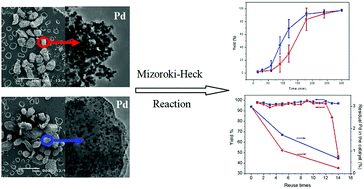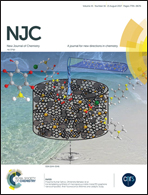Chitosan microspheres-supported palladium species as an efficient and recyclable catalyst for Mizoroki–Heck reaction†
Abstract
Chitosan microspheres-supported palladium catalysts (Pd@CM) for Mizoroki–Heck reaction have been successfully prepared by electrospraying PdCl2/chitosan mixture in a trifluoroacetic acid (TFA) aqueous solution. Swelling capacity measurement and thermal analysis demonstrated that the palladium species in the chitosan microspheres could cross-link the chitosan efficiently. FT-IR spectra demonstrated that the chitosan in the microspheres could be cross-linked by glutaraldehyde, and the formed Schiff bond could chelate the palladium species efficiently. High resolution transmission electron microscopy (HR-TEM) indicated that the entrapment of palladium species in chitosan microspheres could enhance its dispersion. Mizoroki–Heck reaction catalysis results demonstrated that the catalytic activity of Pd@CM was associated with the size of chitosan microspheres. The Pd@CM with a suitable size was even more active than the catalyst with palladium species adsorbed on the surface of chitosan microspheres (Pd-CM). Moreover, the entrapment of palladium species in chitosan microspheres could reduce its aggregation and leaching in the catalysis procedure, which in turn increased the reusability of Pd@CM catalyst. The high catalytic activity and stability of Pd@CM have been attributed to the entrapment of palladium species within the cross-linked chitosan microspheres and the chelation of palladium species with the abundant amine and hydroxyl groups on chitosan chain.


 Please wait while we load your content...
Please wait while we load your content...